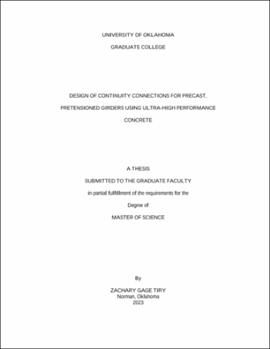| dc.contributor.advisor | Floyd, Royce | |
| dc.contributor.author | Tiry, Zachary | |
| dc.date.accessioned | 2023-05-05T20:49:57Z | |
| dc.date.available | 2023-05-05T20:49:57Z | |
| dc.date.issued | 2023-05-12 | |
| dc.identifier.uri | https://hdl.handle.net/11244/337578 | |
| dc.description.abstract | In recent years, an increased desire to improve the durability and resiliency of bridges has become an important consideration in design. Ultra-high performance concrete (UHPC) is a relatively new cementitious composite material with mechanical and durability properties far superior to conventional concrete. UHPC has high compressive and tensile strength, excellent bond strength to adjacent concrete sections, and a relatively short development length for steel reinforcement. Eliminating joints in a bridge deck with continuous spans can improve the durability of the bridge by reducing the number of pathways for water to penetrate to the bridge structure. The practice of designing connections of precast girders made continuous for live load with conventional concrete is well understood and utilized in practice, but little guidance exists on the structural design of continuity connections made of UHPC or the retrofit of simple spans to be made continuous. The desire to use UHPC is apparent because connections made of conventional concrete often crack during service and the superior properties of UHPC can lead to simpler connection details. Cracking can cause a loss of continuity and allow water to degrade both the reinforcing steel and adjacent concrete. The focus of this research was to investigate how embedment length, UHPC materials, and steel reinforcement geometry affect the performance of connections of pretensioned girders made continuous for live load. A total of six 19 ft long test specimens were constructed to represent a two-span continuous prestressed bridge system. The continuity connections were constructed using two types of UHPC material, a locally developed mix design labeled J3 and a commercially available product. Two types of positive moment steel reinforcement details were tested: 10 in. straight strands and 16 in. long hooked strands, which are both formed as extensions of the prestressing strands in the girders. To replicate the loads a bridge system would experience during service, the specimens were tested to induce both a positive and negative moment in the connection. The measured data correlated well with the literature on the bond strength of UHPC and suggested that hooked strands and longer embedment lengths generally lead to increased load carrying capacity. Additionally, the data suggests that the required dimension and embedment lengths for continuity connections made of UHPC could be smaller than conventional concrete. | en_US |
| dc.language | en_US | en_US |
| dc.subject | Engineering, Civil. | en_US |
| dc.subject | Ultra-High Performance Concrete | en_US |
| dc.subject | Prestressed | en_US |
| dc.subject | Continuity | en_US |
| dc.subject | Live Load | en_US |
| dc.title | Design of Continuity Connections for Precast, Pretensioned Girders Using Ultra-High Performance Concrete | en_US |
| dc.contributor.committeeMember | Volz, Jeffery | |
| dc.contributor.committeeMember | Harvey, Philip Scott | |
| dc.date.manuscript | 2023-05-04 | |
| dc.thesis.degree | Master of Science | en_US |
| ou.group | Gallogly College of Engineering::School of Civil Engineering and Environmental Science | en_US |
| shareok.orcid | 0009-0008-1293-5571 | en_US |
| shareok.nativefileaccess | restricted | en_US |
